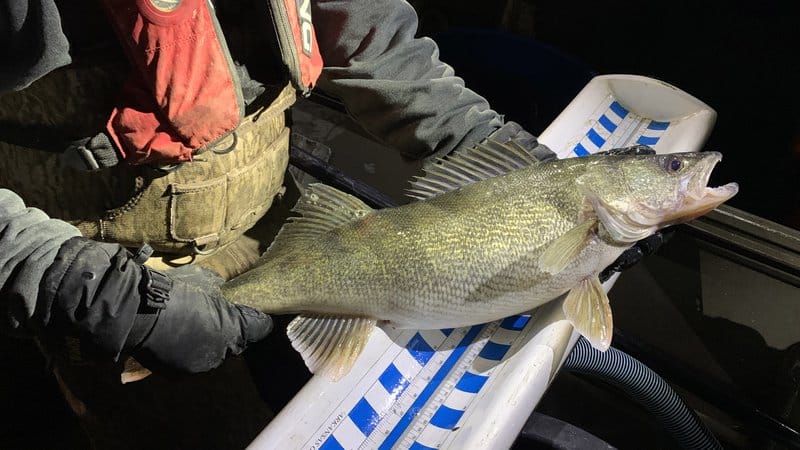AGFC hatchery boosts birthrate in Arkansas walleye
ON 03-29-2023

March 29, 2023
Randy Zellers
Assistant Chief of Communications
CENTERTON — In early March, Arkansas Game and Fish Commission staff from the C.B. “Charlie” Craig State Fish Hatchery in Centerton teamed up with other AGFC staff from northwest Arkansas to gather walleye from the King’s River and boost the success of their spawn for the future of Arkansas angling.
According to Joe Adams, hatchery manager at Centerton, the walleye project is conducted every other year here. During the off years, biologists and staff from the Andrew Hulsey State Fish Hatchery in Hot Springs conduct a similar project in central Arkansas to increase walleye fishing opportunities in that portion of the state.

Each year, walleye swim upstream in late winter to spawn, but the success of that spawn is held entirely to the whims of Mother Nature. The eggs require a steady flow of current to keep them fresh and healthy until they hatch. Too little current and the eggs will be smothered; too much and the water becomes too muddy or flushes the eggs completely out. But hatchery staff can maintain the perfect “Goldilocks zone” to increase the success of the spawning fish exponentially.
“We collected about 70 female walleye and 200 males during the two-night effort this year,” Adams said. “About two-thirds of those female fish were ready to spawn, so we collected their eggs, fertilized them with milt from the male fish and returned the fish to the water unharmed. The rest of the females were brought back to the hatchery with some males and held in separate tanks until they were ready to spawn.”
When the fish are ready to spawn, staff will collect the eggs by slowly pressing against the walleye’s belly to stimulate the process. The eggs are then manually mixed with milt from male walleye to ensure as much fertilization as possible.
“Over the years we’ve actually discovered that the best tool to stir the eggs during the fertilization process is a turkey feather,” Adams said. “Then we add a special clay material called Fuller’s earth, which gives the eggs a light coating and prevents them from sticking together.”

AGFC staff during the two-night project collected and fertilized more than 4.6 million eggs, which are now being cared for at the hatchery in special jars. These hatching jars simulate the needed flow rate with gentle circulation that keeps the eggs moving and suspended in the water.
“It takes eight or nine days for the eggs to begin hatching,” Adams said. “From there, we’ll move them to tanks, then to ponds to grow a little larger before stocking.”
The walleye raised at the hatchery will be stocked into Beaver Lake and Lake Fort Smith, with any extra fish going to Norfork Lake. Additionally, some of the walleye fry will be stocked into a nursery pond on Bull Shoals Lake to grow out there. They will be stocked directly into that lake via direct drain pipe once the fingerlings reach 2 inches long.
“Walleye spawn in all of these lakes naturally, but these stockings help stabilize the numbers of fish available for anglers in those years when weather conditions aren’t ideal for natural reproduction,” Adams said.

CUTLINES:
Walleye on measuring board
AGFC staff at the C.B. “Charlie” Craig State Fish Hatchery collected walleye to help their spawning success last week.
One biologist collecting eggs
Staff gently push against a female walleye’s belly to collect the eggs.
Two biologists working with eggs
Biologists mix eggs with a male walleye’s milt using a turkey feather.
Walleye fry and dime
Dozens of newly hatched walleye could fit on a single dime.
Recent News

Arkansas Wildlife Weekly Fishing Report
Jul. 10, 2025

Lonoke aquaculturist named to AGFC
Jul. 10, 2025
Subscribe to Our Weekly Newsletter E-mails
Don’t miss another issue. Sign up now to receive the AGFC Wildlife Weekly Newsletter in your mailbox every Wednesday afternoon (Waterfowl Reports are published weekly during waterfowl season and periodically outside the season). Fishing Reports arrive on Thursdays. Fill in the following fields and hit submit. Thanks, and welcome!
